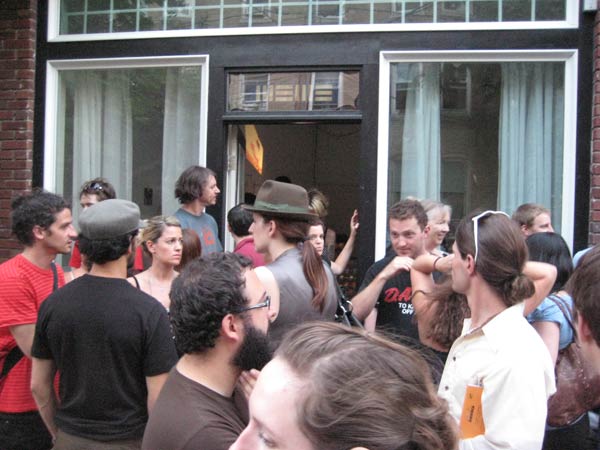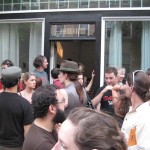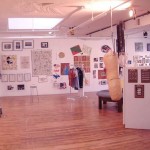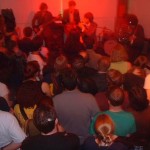Edward Winkleman begins his book How To Start And Run A Commercial Art Gallery with some advice he received from a friend:
"What is an art gallery?" he continued. "It's a space with art on the walls. If you want to open an art gallery, get a space and put art on the walls."
"Wait...er...it's not that simple," I insisted.
"Yes it is," he insisted. "It's exactly that simple. Get a space, put art on the walls, and you will have an art gallery."
He goes on to explain that keeping the gallery open is the hard part, and devotes his book to the specifics of running a commercial art gallery. He offers a number of great resources and insights into the creation of a gallery, and I highly recommend that anyone considering opening a gallery of any type read his book. Yet his initial point remains the most important: you have a gallery when you put artwork out for other people to see.
Since Winkleman has already written a great reference for most of what you need to start any kind of gallery, I thought that I'd focus on some of the specifics of alternative spaces. A thriving city needs active and energetic alternative spaces that function as incubators and experimental sites, so Big RED & Shiny decided to ask some of the leaders of Boston's alternative spaces about their experiences, and extend Winkleman's knowledge into the not-necessarily-commercial gallery realm.
What Is An Alternative Space?
An alternative art space is (by my loose and elastic definition) a place that exists to show art that may not sell, and privileges creative practice and exhibition over profit. This can take many forms, and in the last several decades in Boston we've seen everything from apartment shows to large-scale collectives. There have been spaces started in basements, alleys, attics, and garages. There have been alternative spaces devoted to performance art, new media art, sculpture, as well as spaces whose vision was much less media-specific.
Ellen Wetmore of Boston Sculptors Gallery says of alt spaces: "Who's going to show the stuff with no commercial value and lots of cultural value? We're the test labs for new ideas."
Why Start An Alternative Space?
Alternative spaces often arise from a desire to help an under-served part of the community. In some cases, this is a certain kind of artwork or movement. In others, it is less about the artwork than the kind of dialogue a certain group is having, and a way to unite ideas in a non-academic setting. Starting an alternative space is a lot of work, but it is also a great way to meet the needs of your artistic group if you have the time, temperament and interest.
Tim Bailey, who was director of the former Oni Gallery, said of the value of these spaces: "Art spaces provide a vibrant and active culture to the city. It’s a lot like the charge of a battery. That charge can create all kinds of motion, and reactions. It inspires, promotes activism. It sets into motion a million different sparks creating their own little artistic fires. Some burn for a short while & others burn bright and for a long time."
James Manning, who has run a number of alternative spaces in Boston over the years, explains: "Alternative spaces bridge the gap between art schools and the commercial galleries. They provide a means for experimental forms of art to exist and I believe they provide a means for a more direct interaction and feedback between the artist and their audience. There is a lot of really great artwork made that is unsuitable for commercial spaces. Alternative spaces are even valuable to artists who have some commercial success as it gives them an opportunity to show work that may be unsuitable in another setting."
Finding A Space
Let's face it, there aren't a lot of developers and landlords in Boston begging to give away space to non-commercial art galleries, so starting a new gallery will require some creative thinking. Many alternative spaces have begun in apartments, as parties or short-run shows. Even über-dealer Zach Feuer got is start with an apartment show in Mission Hill, so it is not a bad way to build an audience and get things started. Axiom Gallery in Boston started in an apartment, and recently we have seen a resurgence of apartment shows in the face of ballooning rents.
Nova Benway writes of her apartment show in Jamaica Plain: "I imagine it would be difficult to run a gallery like a business out of your house, but of course, I wasn't trying to do that. I just wanted to clear my space and do a show and get people to come see it. My goal, in some ways, was just to throw a really interesting party: to bring people together and give them something to talk about. The artists that I showed (Nate McDermott, Meg Rotzel, and Shawn Zamechek) are not necessarily striving for major exposure as artists. But their work is interesting and I wanted to spend time thinking and talking about it, and encourage others to do the same, and I found that a great way to do that is to organize a show."
Cynthia von Buehler started the Dietrich von Buehler Gallery at Castle von Buehler in Allston much the same way, and for the same reasons: "We didn't have any overhead as I turned the second floor of my house into a gallery. We even had a separate side door entrance. I like to entertain and would have been doing so anyhow. We were not showing art to sell. We were showing installation exhibits to inspire."
Of course, you may not want a crowd of people passing through your living room. James Manning says of his first gallery space: "One of the biggest drawbacks for me was that at times it can get a bit tedious with the extra work to keep the entire space presentable in the event someone would want to stop by on short notice to see a show, not always that easy to do when your living room is also a gallery." If you don't want a crowd passing through your house every day, you will probably want a dedicated space.
Finding a space that functions as an alternative gallery can be tricky, but not impossible. Finding one that is centrally located, near the subway or in a "safe" neighborhood will be much harder. In Boston, real estate prices in most of the city are driving up the value of condos and building conversions, so many spaces that were once prime options are now gone. But if you look around, you can still find some areas that have great (and cheap) spaces available. East Boston is becoming more viable, and areas of Roxbury (like Fort Hill) have barely been touched by urban renewal. The Berwick Research Institute has been successfully located in Dudley Square for many years, and areas of Jamaica Plain are still reasonable. Of course, if you are inside or outside of Boston, you will need to consult an expert on the specifics of the real estate market in your area.
One of the most effective ways to know what is going on in your area is to keep in contact with other alternative spaces. It is not uncommon for viable spaces to be passed on from one organization to another. Axiom Gallery shared a space with Zeitgeist Gallery before taking over a city-subsidized space when Green Street Gallery closed. The new MEME Gallery was also passed down, as described by Phil Fryer in an interview: "In November, we did a show together called "Congratulations On Your Empire" and a couple of our friends were running this space. It was called 55 Gallery then, and it was time for their lease to come up. They weren't sure if they wanted to continue the lease, but they wanted the space to continue as a gallery, so they asked us if we wanted to take it over."
Finally, when thinking about space, be prepared to change locations. Many alternative spaces move, upgrade, or merge as they build a larger audience and base of support. If you are starting on a shoestring budget, you may not be able to afford a prominent location, but if you do well and find funding, an audience and ways to generate income, you will want to move up.
How Do I Pay For My Alternative Space?
While it is not unprecedented for an alternative space to be run out of pocket, it would not be wise to base the future of an organization on the flexible income of one or two people. Even if you are in a position where you never need money again, it is probably still unwise to run a vanity-only space. Which means you'll be looking for ways to make some money.
While commercial galleries depend on sales, and thus foster collectors and a whole economy around their roster of artists, alternative spaces tend to exist for different reasons and show work that is often less salable. That's usually why they were started in the first place. So how do you make money with a product that you can't consistently sell? Running a gallery out of your home or apartment is one option, since that is a space you already own. Paying the rent on a gallery space is another matter, though.
Here, a long history of innovative artists can provide a number of solutions. Many spaces are built on a hybrid model, where the gallery is part of a larger studio space. Tim Bailey describes the Oni Gallery model this way: "We lived at the gallery, literally. That is how we funded it in the first building. We all paid a certain amount of rent to live (illegally) in an art loft space. Part of our rent went to building and maintaining a gallery space. We were lucky to have begun at a time when there was still plenty of cheap real estate available in Boston. These industrial buildings at the time were virtually unregulated so we could do pretty much anything we wanted."
Other spaces work on similar kinds of models. Boston Sculptors Gallery, Kingston Gallery and FPAC are two types of collectives, in which members fund the gallery through membership fees. MEME Gallery is supported by a small group of leaders, who curate shows of both MEME and outside artists.
Of course, it's possible that a large group of members does not appeal to you, or your space is too small for both studios and a gallery. Even if those are options, you will still need outside revenue. This means fundraising, and lots of it. Plan to dedicate a chunk of time to raising money, and figuring out where your income is coming from.
Grants are an obvious choice for many organizations, but they can be few and far between. The specifics of your organization may direct you toward some specifically targeted private grants, and there is always the Massachusetts Cultural Council that offers operating grants to many organizations. These are well worth your time to apply for, even if you don't get one on the first try. The most important thing is not to give up, because as your organization grows and you build an audience, your chance of receiving large grants grows. Like the issue of finding a space, this is another area where talking to your peers and finding out what is available in your region can go a long way toward helping you find the right funding for your project.
Grants aren't the only way to make money, though. Many spaces have fundraisers of different sorts. The most successful are often those tied to the larger mission of the alternative space. The Berwick hosts a Revolving Dinner in which donors are treated to food, art and ideas in much the same way the Berwick supports their artists. Laconia Gallery (like Green Street before it) hosts a Mad Dash in which supporters race to buy their favorite works of art for low prices. Other spaces host fundraising auctions, donation drives, online campaigns, and a variety of other options.
Fundraisers can also be a great way to raise the visibility of your space, and vice versa. Remember, if you can't get $100 from one person, you can get $1 from a hundred people. This was the Oni Gallery plan, and Tim Bailey describes their first show at 684 Washington this way: "Our first show was a salon show (and annual tradition) where 30+ artists were able to show. Each person brought some friends so we were ensured to have a large crowd. We were able to capitalize on that energy and hit the ground running."
With a little consideration, you can cut a lot of costs through in-kind donations and other forms of support. Many local breweries and liquor stores will donate to your event in exchange for some publicity for their product. A few phone calls to Sam Adams, Harpoon, Tremont Ale, Shipyard and other places can help you have a festive opening for free. The same is true with local restaurants, and if you think you might have a big hit show with a large crowd, why not ask your favorite local eatery for some upscale snacks? The worst they can say is no.
Money can be the most difficult part of running an alternative space, there is no doubt about it. But if you plan ahead, allocate enough time to fundraising and build a strong audience, there is no reason you can't support a space for a long time.
Should The Space Be A Non-Profit Organization?
The decision to incorporate as a non-profit and file for Federal non-profit status (generally known by the tax code section 501(c)(3)), or to form some other type of business, is a very important choice that you should make early on. Each option requires certain contingencies that you should be prepared for. (Please note that as I am not a tax code specialist I will refer to these options generally. You should refer to the specifics of the IRS code and your state laws before making any decisions.)
The most basic option is that you don't incorporate at all, and have a sort of home business. Any income you make through the gallery will be paid via your personal income tax, and any expenditures may be eligible as deductions. When we started Big RED & Shiny, this was our status, however there is strong anecdotal evidence to indicate that this can increase your risk of being audited. However, if you are not making any money, are a very good bookkeeper, or get hives when thinking of filling out IRS forms, then this option might be fine for you.
Incorporation can offer you some protection from having your personal and organizational finances co-mingled. The Limited Liability Corporation (LLC) is a common for-profit option, which leaves your income open to taxation but does not limit what kind of income you can make. Non-profit status provides you with tax-free income, but also restrictions on what kind of money you make. You can start at the IRS website to find out more about 501(c)(3) and if it is a good option for you.
Tim Bailey again: "Oni Gallery was (and I believe still is) a non-profit. We did not start off as one, nor did we really understand what a non-profit was in the beginning. For the first three years all costs were out-of-pocket expenses, which everyone contributed to equally. Eventually we went through the process and became a non-profit. There are definitely benefits to the 501(c)(3) status, such as access to funds. We were able to do so much because we had access (and awesome grant writers) to money. That is what enabled us to have such amazing facilities. The sound system, lights, and projectors all came through grant money. Grants also gave us the ability to fund our film program, library room, and some other specific programs. But it does become a lot more “official”. The influence of money - even through altruistic means - does have some negative aspects. A bottom line was established. Rules had to be followed. The organic nature of the earlier space shifted a little. Not that I would change it. I do think being a non-profit was far more beneficial than not being one but there was a definite change."
If you are just getting started and aren't ready to incorporate, you might want to talk with a local non-profit about fiscal agency. This is a situation in which a non-profit takes on your project as something supported under their mission, and they can accept grants on your behalf from funding agencies that only give to non-profits. The tradeoff is that most groups take a fiscal agency fee (anecdotally, 10% is common in Boston).
Building An Audience
Once you have a space, how do you get people in the doors? Obviously, the Oni plan that Bailey outlines above can get you a lot of attention really fast, but in the long run you'll want to develop a broader strategy to make sure people know what you are up to and how to find out more. Postcards and other handouts can be a good way of passing along information, but they also cost a small amount of money. Online announcements can be cheaper and more focused, but you risk building a narrow audience rather than the broader group you will ultimately want. Most spaces opt for a number of ways of getting the word out: postcards, Facebook, Twitter, a gallery website, listings on arts websites, and many others. A new space called The Hallway in Jamaica Plain has been advertising with Xeroxed fliers stapled to telephone poles!
Whatever options you choose, remember that you want to build an identity for your gallery, and that you want to keep your identity intact as you change promotional formats. Do you have a logo, or a color scheme, or a certain style? Is yours a clean look, or a little grungier? Do you have an air of mystery, or are you clear in your mission? Whatever you choose, be sure to foster that identity in every medium you choose to promote your space. If your audience doesn't know what you're about and why you exist, they probably won't make the trek to your space to see the art you are showing.
Having Fun (While Being Careful)
No one starts an alternative space to be bored and frustrated -- you want to have fun! So, how can you have fun and still keep the doors open?
If recent Boston history is any guide, rule #1 is to pay attention to the legal codes enforced in your area and be sure to have the proper permits and licensing whenever possible. For a party at your home, with some art on the walls, this probably doesn't involve any permits at all (again, I'm not a legal expert so please check!), while a loft space in Chinatown -- with a line of people out onto the street and loud music blaring from all the windows -- might draw more attention and require some better planning.
There is no hard-and-fast rule about when the police will decide to pay attention to your organization, so it's worth it to always be prepared. Are you checking IDs and make sure no underage kids are drinking all your free beer? Are you licensed to serve alcohol or have a live band? Are you willing to spend a lot of time and money fighting that summons if you haven't planned ahead? A little time on your part can go a long way toward a successful space. Besides, you want to spend your time talking about art and not why your latest opening got busted.
Resources To Help You Get Started
Here are just a handful of resources that can help you get started:
IRS website section on 501(c)(3) non-profits
Massachusetts Secretary of the Commonwealth info for Non-Profit Corporations
Volunteer Lawyers for the Arts
Associated Grant Makers of Massachusetts
Artists Foundation
Massachusetts Cultural Council
Conclusion
Everyone I interviewed for this article offered compelling reasons for opening an alternative space, no matter how temporary. I'll end with a few of the best.
Nova Benway: "Alternative spaces allow the public to see all kinds of idiosyncratic work, work that hasn't been "vetted" in an institutional setting, which is probably their greatest value. And I think as a curator too, being able to work on a small enough scale that I could really realize my own vision was powerful. I like that for both the artist and the organizer, there's very little space between you and your audience."
Kathy Bitetti: "They act as incubators for new art forms, important spaces for artists to experiment in and start their careers in, for artists, cultural workers/supporters to learn the ropes so to speak, and they also act as community builders on many levels."
James Manning: "I believe Alternative spaces are completely essential to the overall art scene in Boston. Alternative spaces bridge the gap between art schools and the commercial galleries. They provide a means for experimental forms of art to exist and I believe they provide a means for a more direct interaction and feedback between the artist and their audience. There is a lot of really great artwork made that is unsuitable for commercial spaces. Alternative spaces are even valuable to artists who have some commercial success as it gives them an opportunity to show work that may be unsuitable in another setting. Boston has more art schools and students than just about any other city yet the overwhelming major of these students take off right after graduating, in large part because they get frustrated that Boston does not have the structure to support them. A strong alternative arts scene is key to keeping all of these people in Boston for the long term."
- The crowd outside MEME Gallery in Central Square, Cambridge
- The 30-artist salon show inaugurating Oni Gallery’s third space
- The Strokes play the closing event at Gallery Bershad in 2001
Thanks to Edward Winkleman for inspiring the title of this piece.
MEME image from Big RED & Shiny. Oni and Bershad images from James Manning's extensive collection of photos of alternative spaces in Boston.
Thanks to Nova Benway, Kathy Bitetti, Tim Bailey, Cynthia von Buehler, James Manning & Ellen Wetmore for contributing to this article.






